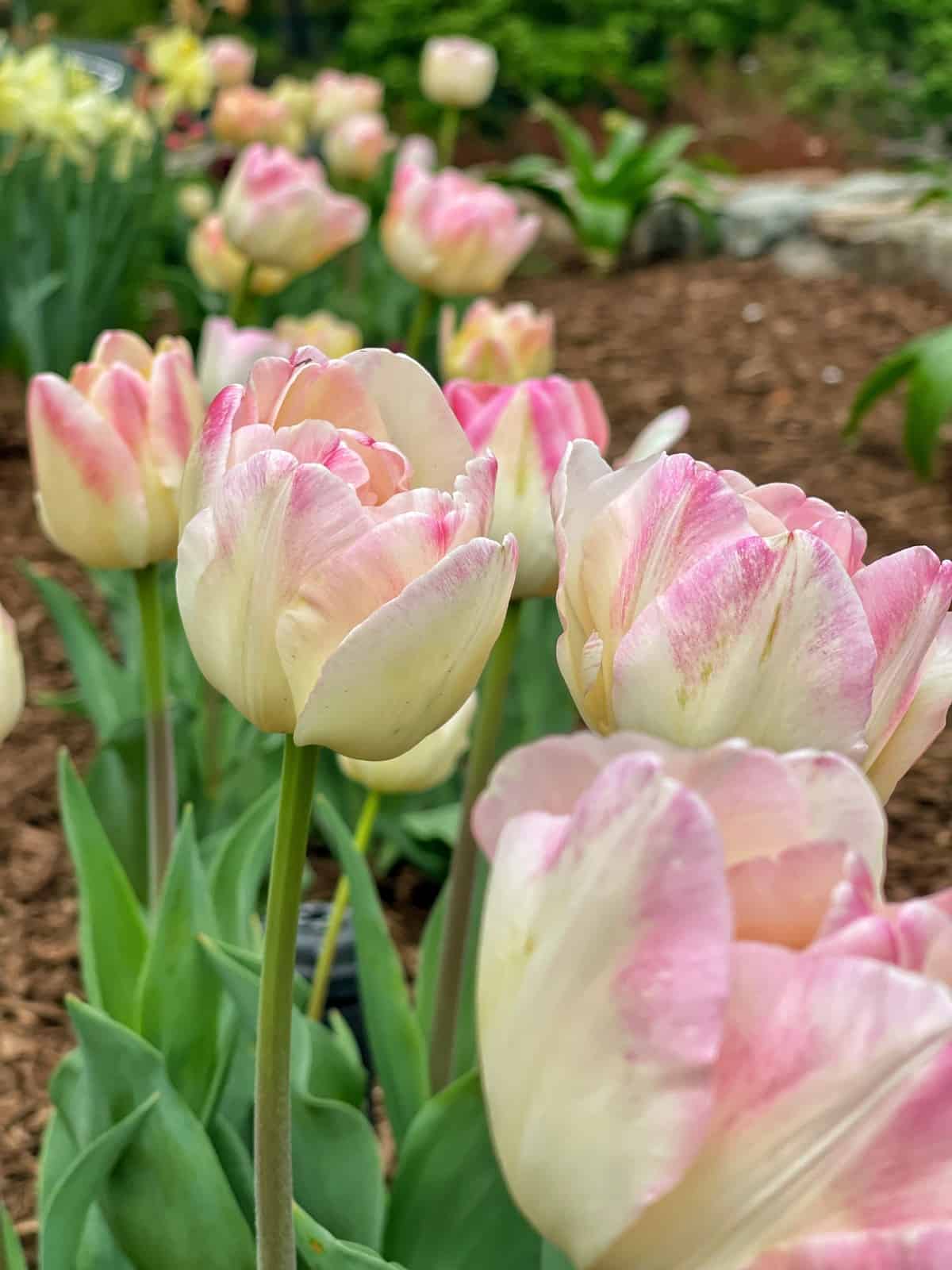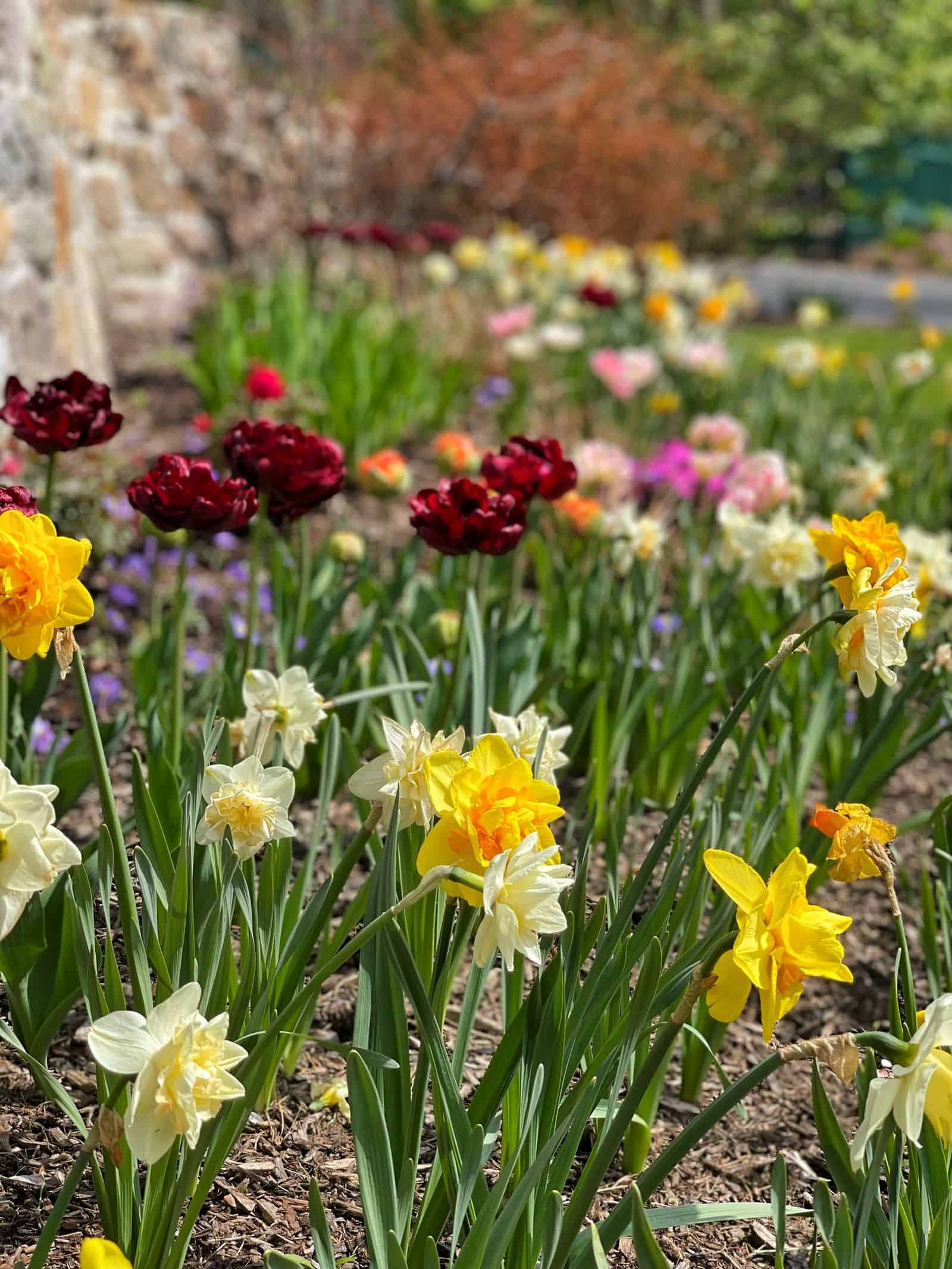Learn how to plant bulbs in the fall and create a stunning spring garden. This guide shares easy-to-follow steps and beautiful results!
As the gardening season winds down, it’s time to start thinking ahead to the vibrant colors of spring. Planting spring-flowering bulbs in the fall might seem counterintuitive because you don’t see an immediate result, but it’s the secret to a breathtaking display of blooms as the winter chill fades.
These bulbs, such as tulips, daffodils, and hyacinths, store the energy they need to flower, lying dormant through winter and bursting into growth as the weather warms.
In this guide, we’ll explore the benefits of fall planting and provide step-by-step instructions on how to plant bulbs for a stunning spring garden.
(Posts on stacyling.com may contain affiliate links. Click HERE for full disclosure.)

Why Plant Bulbs in the Fall?
Planting bulbs in the fall might seem counterintuitive, but it offers several key benefits:
- Strong Root Development: Fall planting allows the bulbs to establish strong root systems before winter sets in.
- Cold Dormancy: Many spring-flowering bulbs require a period of cold dormancy to trigger blooming. Fall planting provides this necessary chilling period.
- Protection: Soil provides insulation from temperature fluctuations and harsh weather conditions, ensuring the bulbs’ survival through the winter.
- Less Competition: Bulbs get a head start before other plants emerge in the spring, giving them ample sunlight and nutrients.
- Efficiency: Planting bulbs is more efficient than starting many plants from seed.
When to Plant
The ideal planting time is when soil temperatures consistently fall below 60°F. This usually occurs in mid-September or October, but can vary depending on your location.
I live in hardiness zone 6b, so I typically wait until the end of October to plant when temps are more consistently cool.

What You’ll Need
- Shovel or hand trowel
- Bulbs
- Bulb fertilizer
- Garden soil
- Organic matter (peat moss or compost)
Choosing Bulbs
Select bulbs that are large, firm, have good color and are free of damage. You can purchase them from local nurseries, big box stores, or online retailers. Some popular spring-flowering bulbs include:
- Tulips
- Daffodils
- Crocus
- Hyacinths
- Grape hyacinths
- Fritillaria
- Alliums
- Anemones
Favorite Sources

How to Plant Bulbs in Fall
- Choose a location: Select a sunny spot in your yard that has good drainage and receives at least six hours of direct sunlight per day.
- Prepare the soil: Loosen the soil and add organic matter to improve drainage and fertility. Before planting bulbs, place them in the garden to plan their design.
- Planting Depth: A general rule is to plant them three times as deep as the bulb’s height. However, always refer to the specific instructions on the bulb packaging.
- Planting: Plant bulbs upright with the pointed ends up and root side down at the recommended depth (see plant tag for planting depth).
- Fertilizing: Before backfilling the hole, add organic matter like peat moss to add drainage and help enrich the soil. It’s also a good idea to mix in a special bulb fertilizer (this is the one that I use). Avoid using bone meal if rodents, skunks, or other small mammals are an issue as bone meal attracts them.
- Backfilling: Backfill the holes with fresh garden soil and water thoroughly.
Pro-Tip: Before planting, place bulbs where you want to plant them to get an idea of how they will look. You can plant in individual holes or group them together.


Caring for Bulbs
- Water the bulbs well after planting and during dry periods in the fall.
- Once the foliage emerges in the spring, fertilize lightly at least two inches from the plant.
- Allow the foliage to die back naturally after flowering to replenish the bulb for the following year.
- Consider planting bulbs among perennials and annuals to camouflage their fading foliage.
Additional Tips
- Planting Depth: Planting depth is crucial. Too shallow, and the bulbs may not survive the winter; too deep, and they may struggle to emerge in the spring.
- Orientation: Make sure to plant with the pointed end up. If planted upside down, the bulb will still grow, but it may take longer and produce a weaker flower.
- Protecting from Wildlife: If deer or other animals are a problem, consider using protective measures such as netting or repellents. If rodents dig up your bulbs, try planting them with chicken wire.
- Spring-Flowering Bulb Tip: Remember! When the flower petals fade, remove the flower parts and stem before the plant goes to seed. Don’t cut leaves back until they turn yellow though. This allows the bulb to store more energy for next year’s flower production.
- Spring Garden Design Tip: Bulb foliage that is dying back can be hidden by planting bulbs in between perennials and annuals. This way will provide color while perennials emerge and are camouflaged by perennials while they die back.
Troubleshooting
If your bulbs fail to bloom, it could be due to several factors, such as improper planting depth, poor drainage, or insufficient sunlight. I shared a comprehensive article that will help you drill down on why this happens and how to fix your spring blooming bulbs here.

Planting Bulbs in Fall FAQs
How Deep Should I Plant?
In general, planting depth should be 3x the size of the bulb. So larger bulbs will get planted roughly 6-8″ deep. While smaller bulbs will be planted around 4-5″ deep. While these figures are a general guide, always consult the plant tag that the bulbs arrived in. The grower knows best how to plant and grow their bulbs. So follow the grower’s recommendations for planting and care.
Should I Soak Bulbs Before Planting?
No, it is not necessary to soak fall bulbs before planting because there should be sufficient soil moisture in the ground. Simply open the bag they arrive in and start planting!

Do You Water Bulbs After Planting?
Yes, it is a good idea to water the bulbs well after planting them in fall to give them a good start in your garden.
What Happens If You Plant a Bulb Upside Down?
While it will still grow, planting it upside down will stress out the plant. And because it gets stressed, could die. And we don’t want that! So the best way to know whether you are planting a bulb correctly is to look for the roots which is usually found at the wide base. And the pointed tip should be upright.

Final Thoughts
Planting bulbs in the fall is like sending a message of hope to the future. As the leaves fall and the days grow shorter, we’re tucking away these little bundles of potential, knowing that they’ll emerge in a riot of color when spring finally arrives.
I’m already envisioning the cheerful faces of tulips and the nodding heads of daffodils greeting me as the snow melts. It’s one of the reasons I love fall planting, and I can’t wait to witness the transformation my garden will undergo in just a few short months.
If you’re looking to add a touch of early spring enchantment to your landscape, I encourage you to give fall bulb planting a try. It’s a simple act that yields extraordinary rewards come spring.
Are you planting spring flowering bulbs? What varieties do you plan to grow? I would love to know more in the comments below.
Thanks for stopping by the blog today!
Enjoy your day! xoxo





















